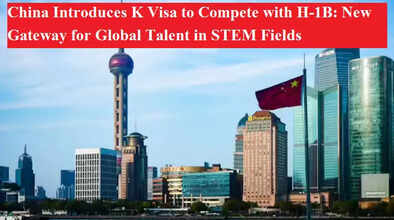China Introduces K Visa to Compete with H-1B: New Gateway for Global Talent in STEM Fields

The United States has long been considered the world’s magnet for global talent, with professionals across science, technology, engineering, and mathematics (STEM) migrating there through the H-1B visa program. However, a new policy shift by President Donald Trump has created ripples worldwide—an additional $100,000 (around ₹88 lakh) fee for H-1B visa applications. This steep increase is expected to make U.S. jobs significantly harder to access, especially for Indian IT professionals and international students.
Sensing an opportunity, China has stepped in with its brand-new “K Visa”, a special category designed to attract foreign professionals who may now find the U.S. inaccessible. Announced officially in September 2025, the K Visa will take effect from October 1, 2025, opening doors for skilled workers, researchers, and young innovators across the globe.
Why China Launched the K Visa
For decades, the U.S. has maintained its dominance in global technology and innovation largely because of the H-1B visa program, which allowed top international talent to contribute to American tech industries. China now aims to replicate and potentially rival this success by offering a more welcoming and flexible visa pathway.
Officials in Beijing have highlighted that the K Visa is specifically targeted at young scientists, engineers, and technology professionals, especially those with academic or research backgrounds in STEM fields. By doing so, China hopes to position itself as the new hub for innovation at a time when many countries, including the U.S., are tightening entry requirements for foreign workers.
Who Can Apply for the K Visa?
According to China’s Ministry of Justice, the K Visa will be open to:
-
Foreign graduates from prestigious universities and research institutions in China or abroad.
-
Talented professionals engaged in teaching or research at well-recognized institutions.
-
Individuals who meet the educational and research qualifications set by Chinese authorities.
Applicants will need to provide verified documents related to their academic qualifications and professional research contributions. Although detailed eligibility criteria are yet to be published, Chinese embassies and consulates worldwide are expected to release official guidelines soon.
Key Benefits of the K Visa
What sets the K Visa apart from other categories is the range of advantages it offers. China currently has 12 types of visas, but government sources suggest that the K Visa will be the most flexible and beneficial. Some expected perks include:
-
Multiple-entry access for easier international travel.
-
Longer validity and extended stay periods compared to existing work visas.
-
No mandatory sponsorship, making the application process simpler for independent professionals.
-
Opportunities for visa holders to engage in academic exchanges, research collaborations, and cultural activities.
-
The ability to launch personal business ventures in China, offering more entrepreneurial freedom than traditional work visas.
Global Impact and India’s Perspective
The sudden hike in H-1B visa fees has caused concern among Indian tech companies and students, many of whom rely on U.S. work opportunities. With China’s K Visa now entering the picture, experts believe some of this talent may redirect toward Beijing, Shanghai, or other Chinese innovation hubs.
For India, which has one of the world’s largest pools of STEM talent, the K Visa could be both an opportunity and a challenge. While it provides Indian professionals with an alternative to the U.S., it also means that China may gain a competitive edge in retaining global talent that traditionally flocked to Silicon Valley.
The Bigger Picture
China’s launch of the K Visa is more than just an immigration reform—it’s a strategic move to reshape global talent flows. By offering a cheaper, more accessible, and attractive pathway, Beijing is positioning itself as a direct competitor to the U.S. in the race for technological dominance.
As the policy comes into force on October 1, the world will closely watch how many skilled professionals make the shift from America’s Silicon Valley dreams to China’s fast-growing innovation ecosystem.
👉 In short, while the U.S. raises barriers with costly H-1B visa fees, China is lowering them with the K Visa—potentially rewriting the future of global workforce mobility.

